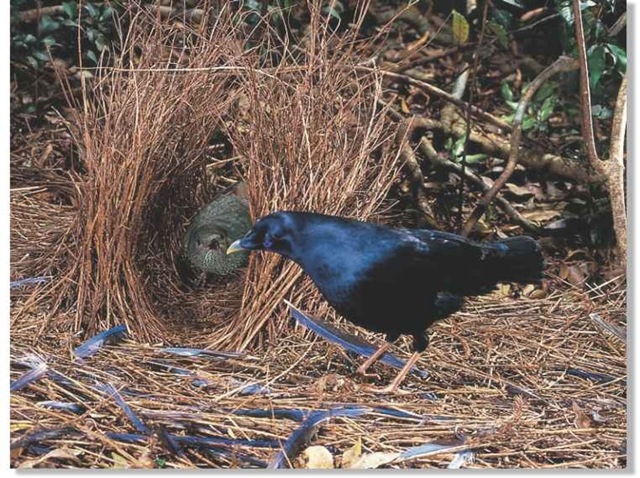ORDER
Passeriformes
FAMILY
Ptilonorhynchidae
GENUS & SPECIES
KEY FEATURES
Builds structures purely to attract mates t Regarded by some ornithologists as one of the most advanced of all birds, it uses a tool and mixes “paint” to color the walls of its bower ► Makes a “dance floor” decorated with blue objects, including clothespins stolen from clotheslines
WHERE IN THE WORLD!
Found in a 150-mile wide coastal strip of Australia, from Victoria to southern Queensland; a separate population lives in northern Queensland
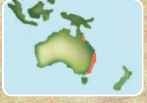
Lifecycle
Many birds have spectacular courting displays, but only the bowerbird builds and decorates an elaborate bower that serves as a dance hall and shop window for his trinkets.
Habitat
The satin bowerbird is a bird of the forest, where it builds its bowers and nests. The main population lives in an area 150 miles wide and 1,200 miles long, from Victoria through New South Wales and up to southern Queensland.
Another population is in a 300-mile-long strip of northern Queensland. Bowerbirds in this population are smaller than their southern counterparts, but they’re the same species; the 600-mile gap between the two ranges is the result of deforestation, followed by the spread of low-growing plants.
Found near sea level to around 3,500′, the bird thrives in dense rainforest in northern parts of its range, but is also at home in more open woodlands farther south. The bowerbird will even visit gardens in the busy suburbs of Sydney capital of New South Wales — and in winter; outside the breeding season, sizable flocks may visit open farmland.
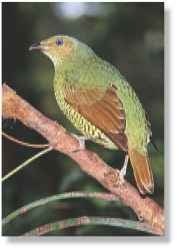
A Woodland home The female bowerbird’s muted colors help her blend into the forest.
Rival males steal trinkets from an unguarded bower and may demolish it if the owner doesn’t return in time.
The bowerbird is an accomplished mimic, whose repertoire has been known to include the mew of a cat.
Early naturalists who discovered strange, decorated twig structures deep in the rainforest thought they were done by native people.
The great gray bowerbird collects white or gray objects (bones and shells).
Breeding
The bowerbird has evolved a unique courtship behavior that eliminates the need for flamboyant but cumbersome plumes worn by the closely related birds of paradise. Courtship centers on the elaborate display that the male puts on around his bower whenever a female arrives within range — a ritual that commonly takes place in the early morning from April through September
When a female arrives, the brightly colored male begins an elaborate display dance, hopping stiff-legged around his collection of ornaments, often carrying one in his bill. Excitement increases, and his eyes bulge as the female enters the bower’s avenue.
The female may appear uninterested, casually arranging a twig as the male cavorts. He flicks his wings and tail while “singing” in a voice compared to crashing of gears. If the female is impressed, she will crouch between the bower walls, where mating then takes place.
The female builds a nest to incubate her eggs and rear the chicks without the male’s help. The saucer-shaped nest, built in a tree, is made with twigs and lined with leaves.
Immature males resemble their mothers in plumage and practice bower-building before acquiring full adult feathers. Their flimsy early efforts betray their inexperience.
Caring mother The female makes a solitary nest in the trees to rear her chicks in.
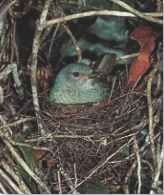
Come into my parlor The brightly colored male dances around his bower to entice a female to enter.
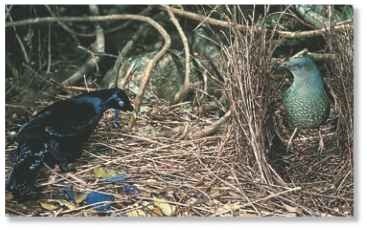
behavior
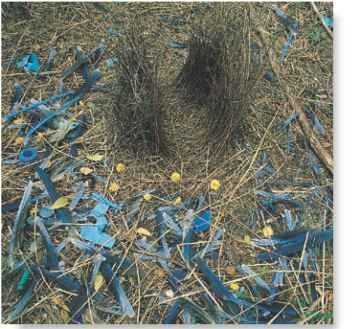
To attract his mate, the male bowerbird gathers sticks and assorted trinkets, with which he plies his skill as an architect, builder and decorator
After carefully constructing a twig avenue on the forest floor; he chooses decorations, arranging them around the sunny northern entrance. He favors blue, but may use yellowish-green ornaments, like the female’s plumage. If anything outside his color scheme (such as a white flower) falls onto the bower, he’ll quickly remove it
The male bowerbird is one of the few birds known to use tools. He forms soft bark or other plant fiber into a “sponge” to absorb a mixture of saliva and bushfire charcoal, holding the sponge in his bill to daub the bower’s inner walls. He also “paints” the twigs by rubbing them with the juice of pulped blueberries.
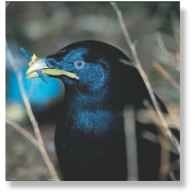
master builder
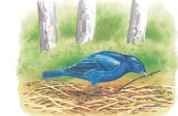
Plan…
The bower is aligned north-south, possibly to give the best, dazzle-free views from either end in early morning.
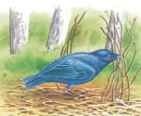
Build…
The bird takes two days to build the 5″-wide avenue of his bower, formed between two 12″-high, inw arching walls made from twigs.
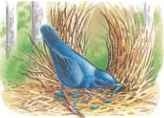
Decorate…
The bird constantly adds and rearranges feathers, flowers and man-made objects — usually blue to match his own color.
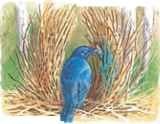
Paint
The bowerbird finishes the walls of the bower by painting them with berry juice or a dark paste he makes from bushfire charcoal.
Food & feeding
The bowerbird feeds mainly on a wide variety of fruits and berries, but will also snap up any insects that it finds, including beetles, moths and termites. The chicks, which need a high-protein diet for their rapid development, are fed chiefly on insects.
The bowerbird forages mainly in the forests where it breeds. Outside the nesting season, birds flock up to a hundred and search for figs and other fruit. When fruit is scarce, the bowerbird normally resorts to a diet of buds, flowers and even leaves.
Insect additives The bowerbird searches for grubs on the forest floor.
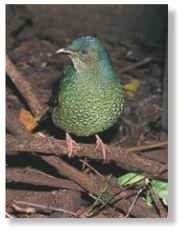
conservation
The satin bowerbird is fairly common in most of its range. Chief threats to its future are forest clearance and shooting by fruit growers, which has led to the extermination in some localized areas.
Profile
Satin Bowerbird
Attractive without being showy, the satin bowerbird gets its name from the sheen on the male’s smart, blue-black plumage.

Creature comparisons
The satin bowerbird’s elaborate “bower” is overshadowed by the Vogelkop gardener bowerbird of New Guinea, which builds an astonishing courting place — a “hut” up to 5′ wide with a moss “front garden” on whic he arranges flowers and fruits. MacGregor’s bowerbird builds a 2′-high twig “maypole” ringed by a circular “dance floor.”
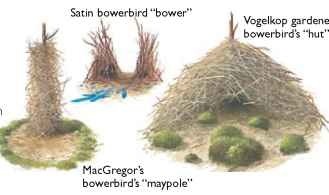
| VITAL STATISTICS | |
| Weight | About 5 oz. |
| Length | 11-13.5″. |
| Wingspan | 18-20″ |
| Sexual Maturity | Female 2 years; male 4-6 years |
| Breeding season | September -February |
| Number of Eggs | 1 or 2, sometimes 3 |
| Incubation : Period | 19-23 days |
| Number of Broods | 1 |
| Fledging Period | 18-22 days |
| Typical Diet | Mainly fruit and berries; some insects |
| Lifespan | Probably up to 15 years |
RELATED SPECIES
• The bowerbird family has 18 species in New Guinea and Australia, but not all build bowers. Four species known as catbirds, because of their catlike calls, form a stable pair bond; the other 14 species don’t. Bowerbirds lack the splendid plumes of closely related birds of paradise, but some, like the male I regent bowerbird, are boldly colored. MacGregor’s bowerbird Ehas dun plumage and a flame-orange crest.
